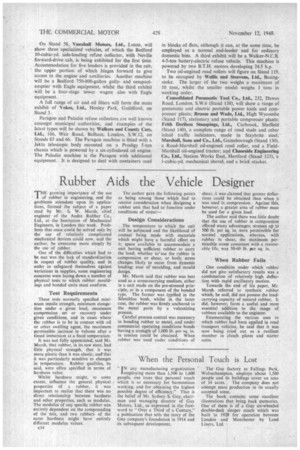Rubber Aids the Vehicle Designer T HEgrowing importance of the use
Page 52

If you've noticed an error in this article please click here to report it so we can fix it.
of rubber in engineering, and the problems attendant upon its applications, formed the subject of a paper read by Mr. S. W. Marsh, chief engineer of the Andre Rubber Co., Ltd., at the Institution of Mechanical Engineers, in London this week. Problems that once could be solved only by the use of relatively complicated mechanical devices could now, said the author, be overcome more simply by the use of rubber.
One of the difficulties which had to be met was the lack of standardization in respect of rubber quality, and in order to safeguard themselves against variations in supplies, some engineering concerns were laying down a number of physical tests to which rubber mouldings and bonded units must conform.
Test Requirements These tests normally specified minimum tensile strength, minimum elongation under a given load, maximum compression set or recovery under given conditions, and in cases where the rubber is to be in contact with oil or other swelling agent, the maximum permissible increase in volume after a timed immersion at a fixed temperature.
It was not fully appreciated, said Mr. Marsh, that rubber, in its raw state, had little physical strength, that it was more plastic than it was elastic, andthat it was particularly sensitive to changes in temperature. Rubber qualities, he said, were often specified in terms of hardness value.
Whilst hardness might, to some extent, influence the general physical properties of a rubber, it was important to realize that there was no direct relationship between hardness and other properties, such as modulus. The modulus of any specific rubber was entirely dependent on the compounding of the mix, and two rubbers of the same hardness might have entirety different modulus values.
ct 4
The author gave the following points as being among those which had to receive consideration when designing a rubber unit that had to function under conditions of stress:— Design Considerations The temperature to which the unit will be subjected and the likelihood of contact being made with materials which might have a harmful effect on it; space available to accommodate a unit having sufficient rubber to carry the load; whether to/use the rubber in compression or shear, or both; stress changes likely to occur from dynamic loading; ease of moulding, and mould design.
Mr. Marsh said that rubber was best used as a stress-carrying medium, either in a unit made on the pre-stressed principle, or in a component of the bonded type. The former was typified in the Silentbloc bush, whilst in the latter case, the rubber was firmly anchored to the metal parts by a vulcanizing process.
Careful process control was necessary in bonding rubber to metal, and under commercial operating conditions bonds having a strength of 1,000 lb. per sq. in. in tension could be obtained. When rubber was used under conditions of
shear, it was claimed that greater deflections could be obtained than when it was used in compression. Against this, however, a greater area of rubber must be used for a given load.
The author said there was little doubt that the use of rubber in compression offered many advantages; stresses up to 500 lb. per sq. in. were permissible for normal applications, whereas, with rubber in shear, the maximum permissible stress consistent with a reasonable life, was 50-60 lb. per sq. in.
When Rubber Fails One condition under which rubberdid not give satisfactory results was a combination of relatively high deflection with rapid oscillatory motion.
Towards the end of his paper, Mr. Marsh referred to synthetic rubber which, he said, did not possess the loadcarrying capacity of natural rubber. It did, however, form a useful and most essential addition to the range of rubbers available to the engineer.
Enumerating the various uses to which rubber had been applied in road transport vehicles, he said that it was now being tried out as a resilient member in clutch plates and starter units.




























































































